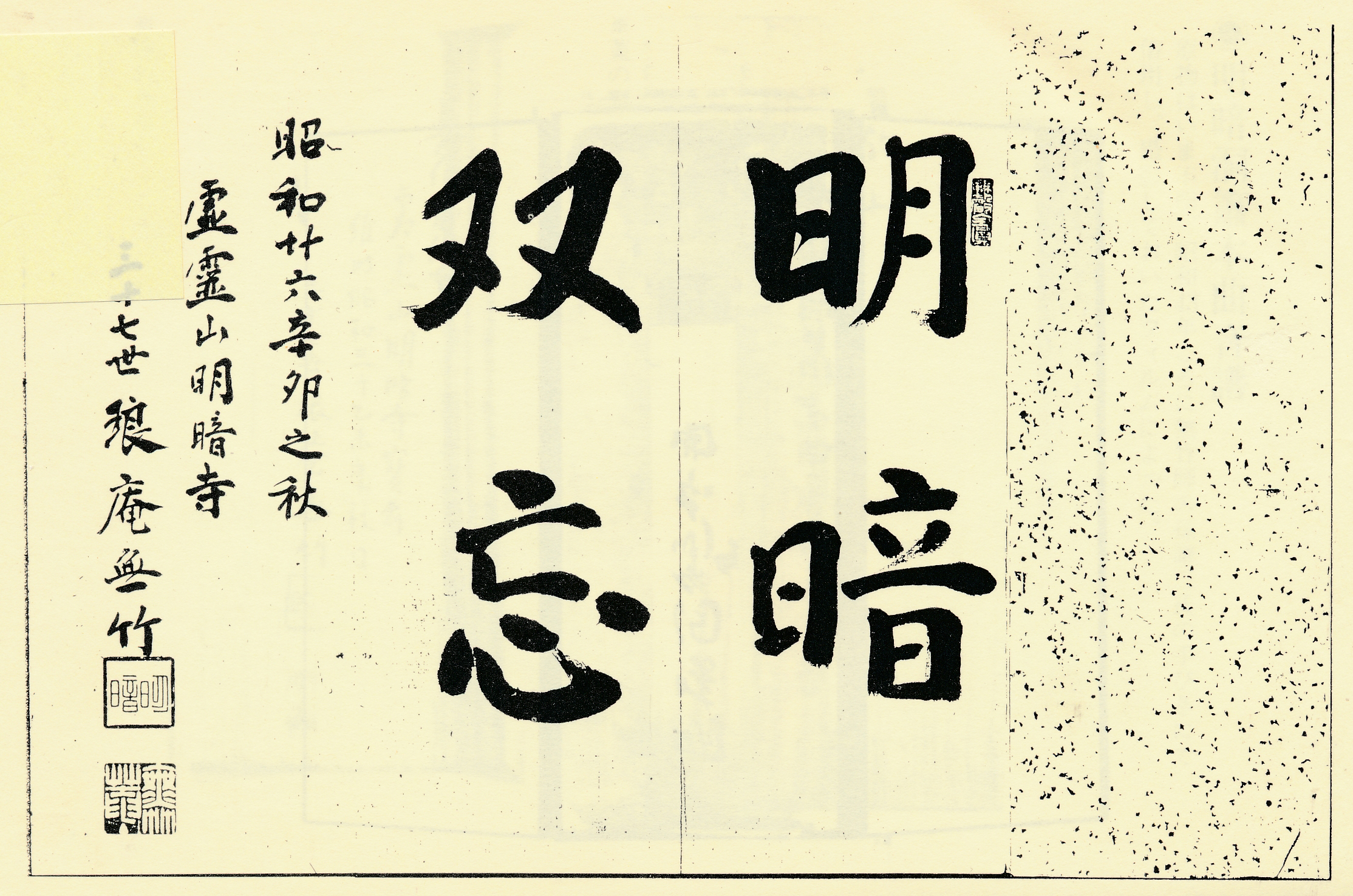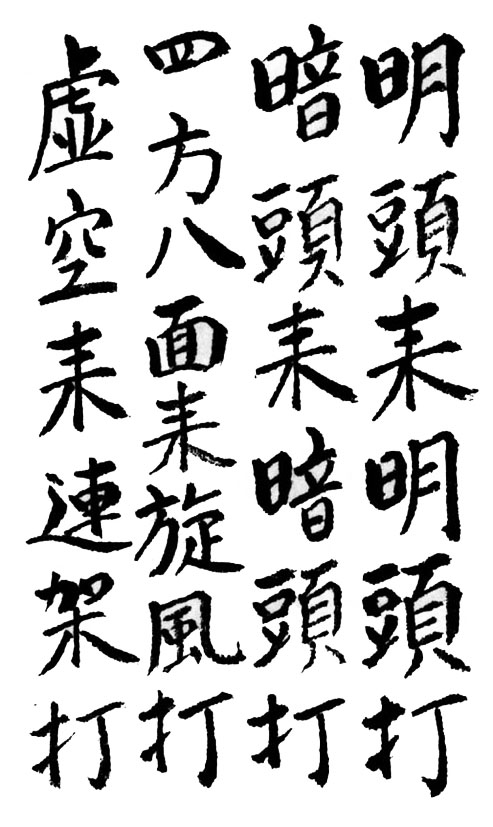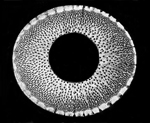|
The True Meaning of 'Myō-An Sōzō'
- "Light & Darkness" Acc. to Hui-neng, Shi-t'ou, and P'u-k'o
明暗雙雙 / 明暗双双
MYŌAN SŌZŌ
"The Dualistic Pair of 'Myō' & 'An', "The Bright vs. The Dark" - "Brightness" vs. "Darkness".
On the Non-Dualism of Enō/Huineng, Sekitō/Shih-t'ou, and Fuke Zenji/P'u-k'o Ch'an-shi.
惠能 - 希遷 - 普化
The Most Mistaken and Misleading English Translations
in the Entire History of Ascetic Shakuhachi Pseudo-Ideology:
9th Century Fuke Zenji's Statement on 'Myō' & 'An'
Neither "Bright-Heads" Nor "Dark-Heads" are in Play Here!

'Myō-An Sō-Bō', "Forget the Duality of the Light-Darkness Pair.
Calligraphy by Tanikita Muchiku, apparently dated 1941.

Early 9th century Fuke Zenji's 4-line statement on the Duality of 'Myōan'.
Calligraphy in a Tani-ha/Kyotaku Tradition 'gakufu orihon' by Nishimura Kokū, possibly 1970s?
明頭来 明頭打
暗頭来 暗頭打
四方八面来 旋風打
虚空来 連架打
FIRST, LET'S PRESENT THAT TEXT in ENGLISH, WORD to WORD:
"Bright/Light + Noun suffix + comes
- Bright/Light+ Noun suffix + strikes/hits
Dark + Noun suffix + comes
- Dark+ Noun suffix + strikes/hits
Four Corners + Eight Directions + come
- Whirl Wind + strikes/hits
Empty/False + Sky + comes
- Flail/Scythe + strikes/hits"
Which is to say, literally:
"Brightness comes - Brightness strikes
Darkness comes - Darkness strikes
Four Corners Eight Directions come - Whirl Wind strikes
Empty Sky comes - Flail strikes."
THEN, LET'S "TRANSLATE" THOSE PLAIN WORDS into MODERN JAPANESE (re GOOGLE):
明るさがやってくる - 明るさが襲う
暗闇がやってくる - 暗闇が襲う
四隅八方からやってくる - 旋風が襲う
空がやってくる - からかいが襲う
RE-TRANSLATING into ENGLISH (re GOOGLE):
"Light is coming - Light is attacking
Darkness is coming - Darkness is attacking
Coming from all sides - Whirlwinds are attacking
The sky is coming - Teasing is attacking"
HOWEVER NOW, WHAT ACTUALLY WENT WRONG WITH "TRANSLATING" FUKE's WORDS in the WEST from 1977?
EXAMPLE 1: Anonymous failed "translation" presented online by Kyōto Myōan Temple, re-observed in February 2025:
"If attacked in the light, I will strike back in the light.
If attacked in the dark, I will strike in the dark.”;
“If from all quarters, I will strike as a whirlwind does.
If attacked from the empty sky, I will thrash with a flail.
(transl. Genichi Tsuge)"
Link to the Kyōto Myōan Temple's official web page, English language page
EXAMPLE 2: The closely identical, original Tsuge Gen'ichi "translation" published in Asian Music magazine as early as in 1977:
"If attacked in the light, I will strike back in the light.
If attacked in the dark, I will strike in the dark.
If attacked from all quarters, I will strike as a whirlwind does.
If attacked from the empty sky, I will trash with a frail."

Fuke Zenji's four line statement about 'Myō-An' translated by Tsuge Gen'ichi,
printed in 'Asian Music' magazine in 1977.
In other words: The My%#0333;an Temple did nothing at all to check and correct Tsuge Gen'ichi's first, utterly non-sensical "translation"
and interpretation before it was republished on the temple's own website.
Tsuge Gen'ichi, 柘植元一, is the name of a renowned 20th century Japanese musicologist
who researched and published about a variety of music related subjects in his capacity as professor at the Tokyo Unversity of Fine Arts, a.k.a. 'Geidai'.
Not much is otherwise written about him.
Link to "Tsuge Gen'ichi" c/o komuso.com:
http://www.komuso.com/people/people.pl?person=1000&lang=39
Reference:
Tsuge Gen'ichi: 'The History of the Kyotaku.'
In: Asian Music, Vol. VIII, 2. New York, 1977.
Link to online PDF file:
http://links.jstor.org/sici?sici=0044-9202(1977)8%3A2%3C47%3ATHOTK%3E2.0.CO%3B2-M
Why have contemporary Myōan Temple people not done anything at all to investigate and improve that English "translation" even the slightest?
The original text is, first of all, not written in modern Japanese, but in 9th century classical Chinese, NB!
Two languages that are fundamentally different in both syntax, grammar, and quite much also semantically, not least.
EXAMPLE 3: Here you have U.S. Japanologist James H. Sanford's "translation", dated 1981:
"P'u-k'o was always going about the streets ringing a hand-bell and saying,
'If a bright-head comes, strike the bright-head.
If a dark-head comes, strike the dark-head.
Whatever direction or quarter it comes from,
hit it like a whirlwind.
And if it comes from emptiness, cut it down with a scythe.'"
Reference:
James H. Sanford: Zen-man Ikkyū.
Harvard University Center for the Study of World Religions, 1981.
EXAMPLE 4: Here you have Riley Kelly Lee's "translation", presented in his 1992 PhD thesis, section "3.5.3 The San'in sangu":
'If a bright-head (
明頭, J. meitō) comes, strike the bright-head.
If a dark-head
暗頭, J. antō) comes, strike the dark-head.
Whatever direction of quarter it comes from, hit it like a whirlwind.
And if it comes from emptiness, cut it down with a scythe'.
No, no, no, of course, there's no "bright-head" at work here - Fuke's words were written in Chinese, not Japanese!
So, what's so really wrong with those various renderings in English, as well as with several more of a closely similar kind?
First, do read the original Chinese wording as once presented in the Lin-chi lu / Rinzai roku, Chapter 29:
明頭来 明頭打
暗頭来 暗頭打
四方八面来 旋風打
虚空来 連架打
Míng tóu lái,
Míng tóu dǎ,
Àn tóu lái,
Àn tóu dǎ,
Sìfāng Bā Miàn lái,
Xuànfēng dǎ,
Xū-Kōng lái,
Lián jià dǎ.
Read in Japanese:
Myō-tō rai,
Myō-tō da,
An-tō rai,
An-tō da,
Shihō Hachimen rai,
Senpū da,
Ko-Kū rai, Renga da.
Find more examples on this local web page:
• CHINA 2: 500 CE ...
So, for a start: What so wrong with those above quoted "translations"?
1: There are no sentence subjects, personal pronouns, like "I", responsible for any "striking", "beating" or "hitting" action here.
2: There are no "heads" at work, in play here!
The word 't'ou'/'tou',
頭,
in classical Chinese - in Japanese: 'tō', does not mean "head" here, at all,
but functions as an "N.A. noun suffix", i.e. "Numerary Adjunct or classifier of nouns."
Or, also: "Substantive marker".
Therefore: No "Bright-heads", no "Dark-heads", are at work, in play here!

Detail scanned from R.H. Mathews' "Chinese-English Dictionary", 1966, p. 941.
3: In this particular Chinese Mahayana Buddhist context, 'Ko-kū',
虚空,
definitely does not mean "Empty Sky" but "Non-Duality", "Lack, or Absence, of Duality".
However, there is in fact quite more to all this when Fuke's words are appreciated in a much wider context:
From the perspective of a Non-Dualistic world view and experience that was inherited from Indian Advaita Vedanta philosophy
more than two and a half millenia ago.
THE BACKGROUND, the IDEOLOGOCAL CONTEXT: FUKE ZENJI responded to HUI-NENG and SHIH-T'OU!
大鑒惠能 Ta-chien Hui-neng/Daikan Enō 638-715
石頭希遷 Shih-t'ou Hsi-ch'ien/Sekitō Kisen 700-790
普化禅師 Fuke Zenji active early 9th century
Read more here:
Huineng, Shih-t'ou & P'u-k'o on 'Myōan sōsō
- The Complementary Pair "The Bright" and "The Dark"
• CHINA 2: 500 CE ...
Cheers - Torsten Olafsson, Denmark, January, 2025.
|
|




